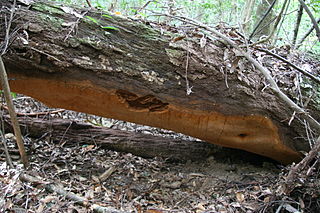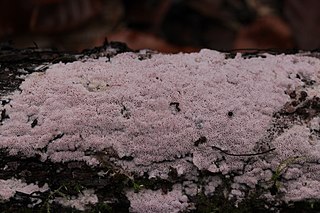Related Research Articles
Megasporoporia is a genus of four species of crust fungi in the family Polyporaceae. The genus is characterized by its large spores, and dextrinoid skeletal hyphae.

Skeletocutis is a genus of about 40 species of poroid fungi in the family Polyporaceae. The genus has a cosmopolitan distribution, although most species are found in the Northern Hemisphere. It causes a white rot in a diverse array of woody substrates, and the fruit bodies grow as a crust on the surface of the decaying wood. Sometimes the edges of the crust are turned outward to form rudimentary bracket-like caps.

Phellinus ellipsoideus is a species of polypore fungus in the family Hymenochaetaceae, a specimen of which produced the largest fungal fruit body ever recorded. Found in China, the fruit bodies produced by the species are brown, woody basidiocarps that grow on dead wood, where the fungus feeds as a saprotroph. The basidiocarps are perennial, allowing them to grow very large under favourable circumstances. They are resupinate, measuring 30 centimetres (12 in) or more in length, though typically extending less than a centimetre from the surface of the wood. P. ellipsoideus produces distinct ellipsoidal spores, after which it is named, and unusual setae. These two features allow it to be readily differentiated microscopically from other, similar species. Chemical compounds isolated from the species include several steroidal compounds. These may have pharmacological applications, but further research is needed.

Wolfiporia curvispora is a species of fungus in the order Polyporales. It is found in Jilin, China, where it grows on the rotting wood of Pinus koraiensis. The fungus was described as new to science in 1998 by mycologist Yu-Cheng Dai. The fruitbodies of the fungus are resupinate, meaning they lie flat on the substrate, and have dimensions of up to 3 metres (10 ft) long by 70 cm (28 in) wide by 1 centimetre (0.4 in) thick. They are creamy white, soft, and light. The hyphal system is dimitic, comprising generative and skeletal hyphae. The specific epithet curvispora refers to the curved spores.

Skeletocutis amorpha is a species of poroid fungus in the family Polyporaceae, and the type species of the genus Skeletocutis.
Skeletocutis brevispora is a species of poroid crust fungus in the family Polyporaceae. It was described as new to science in 1998 by Finnish mycologist Tuomo Niemelä.
Haploporus thindii is a species of poroid crust fungus in the family Polyporaceae. Found in China and India, it causes a white rot in woody substrates.
Skeletocutis luteolus is a species of poroid crust fungus in the family Polyporaceae. It is found in southern and eastern China, where it causes white rot.
Megasporoporia minuta is a species of crust fungus in the family Polyporaceae. Found in the Guangxi Autonomous Region of southern China, it was described as a new species in 2008 by mycologists Xu-Shen Zhou and Yu-Cheng Dai. The fungus produces annual to biennial fruit bodies with small pores, numbering 6–8 per millimetre. The spores are cylindrical to oblong-ellipsoid and measure 7.7–9.7 by 3.6–4.9 μm. The hymenium lacks both hyphal pegs and dendrohyphidia.
Skeletocutis subvulgaris is a species of poroid, white rot fungus in the family Polyporaceae. Found in China, it was described as a new species in 1998 by mycologist Yu-Chen Dai. It was named for its resemblance to Skeletocutis vulgaris. The type collection was made in Hongqi District, Jilin Province, where it was found growing on the rotting wood of Korean pine.
Leifiporia is a genus of two species of poroid white rot crust fungi in the family Polyporaceae. The genus was circumscribed by Chinese mycologists in 2016 to accommodate the type species Leifiporia rhizomorpha.
Pyrofomes castanopsidis is a species of polypore fungus in the family Polyporaceae. It was described as new to science in 2011 by Chinese mycologists Bao-Kai Cui and Yu-Cheng Dai. The type collections of the fungus were made in Luofushan Forest Park in Huizhou, where the fungus was discovered growing on a live plant of Castanopsis. The specific epithet castanopsidis refers to the genus of the host plant.
Postia duplicata is a species of poroid fungus in the family Fomitopsidaceae that was described as a new species in 2014. It is found in Yunnan and Zhejiang provinces of China, where it causes a brown rot on angiosperm wood. The fungus is named (duplicata) for its characteristic two-layered context, a feature that distinguishes it from other Postia species. The spores made by this fungus are cylindrical, hyaline, smooth, and typically measure 3.8–5.8 by 1.8–2.5 µm.
Steccherinum subglobosum is a hydnoid fungus of the family Steccherinaceae. Found in China, it was described as new to science by mycologists Hai-Sheng Yuan and Yu-Cheng Dai in 2005. The type collection was found growing on a fallen angiosperm branch in Shennongjia Nature Reserve. The specific epithet subglobobum refers to the somewhat rounded shape of its spores.
Datroniella tropica is a species of crust fungus in the family Polyporaceae. Found in southwestern China, it was described as a new species in 2014 by mycologists Bao-Kai Cui, Hai J. Lee, and Yu-Cheng Dai, who placed it in the new genus Datroniella. The type collection was made in Tongbiguan Nature Reserve, where the fungus was found growing on a fallen angiosperm branch. The specific epithet tropica refers to its distribution in tropical China.
Dentocorticium hyphopaxillosum is a species of crust fungus in the family Polyporaceae. It is found in the Guangxi Autonomous Region of southern China, where it grows on fallen angiosperm branches. It was first described in 2014 as Dendrodontia hyphopaxillosa by mycologists Meng-Jie Li and Hai-Sheng Yuan, who thought it was related to other species of Dendrodontia based on morphological characteristics. It was transferred to the genus Dentocorticium in 2018 based on phylogenetic analysis; Dendrodontia was synonymized with Dentocorticium. Characteristics of D. hyphopaxillosum include its crust-like fruit bodies, cylindrical hyphal pegs, contorted dendrohyphidia that are frequently branched, and spores with an ellipsoid to somewhat cylindrical shape.

Ceriporia excelsa is a species of crust fungus in the family Irpicaceae. It is found in Europe and North America, where it typically grows on dead hardwood. It has also been recorded from China.
Postia amylocystis is a species of poroid fungus in the family Fomitopsidaceae. Found In China, the fungus was described as new to science in 1994 by mycologists Yu-Cheng Dai and Pertti Renvall. The original type collections were made in the Changbai Mountain Range, where the fungus was found growing on a decayed trunk of Manchurian lime. Characteristics that distinguish P. amylocystis from other Postia species include thick-walled cystidia in the hymenium, and narrow, sausage-shaped (allantoid) spores. The specific epithet amylocystis refers to the amyloid cystidia, and hints at a possible phylogenetic relationship to Amylocystis lapponica.
Skeletocutis fimbriata is a species of poroid fungus in the family Polyporaceae. Found in China, it was described as new to science in 2008. The holotype collection was made in the Shennongjia nature reserve in northwestern Hubei province, where it was found growing on rotting angiosperm wood. The fungus is distinguished from the other Skeletocutis species by its narrow spores, and its coarsely fimbriate margin on the fruit bodies. The specific epithet fimbriata refers to this latter characteristic.
Ungulidaedalea is a fungal genus in the family Fomitopsidaceae. The genus was circumscribed by Chinese mycologists in 2016 to contain the single species Ungulidaedalea fragilis, a fungus that was described as new in 2014 with the name Fomitopsis fragilis. The holotype of this fungus was collected in Jianfengling Nature Reserve, in Ledong County (Hainan). The generic name Ungulidaedalea refers to the resemblance between this species and Daedalea, and also to the hoof-shaped (ungulate) form of the fruit body. Ungulidaedalea fragilis has rather fragile fruit bodies with a dark brown crust and large angular pores on the cap underside. Microscopic characteristics include its densely septated skeletal hyphae, and oblong-ellipsoid spores that measure 4–5.2 by 2.2–2.8 μm.
References
- ↑ Dai, Yu-Cheng (2011). "Two new polypores from tropical China and renaming two species of Polyporus and Phellinus". Mycoscience. 53 (1): 40–44. doi:10.1007/s10267-011-0135-2. S2CID 85172197.